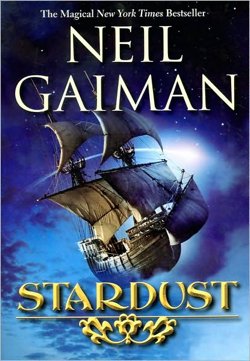Take a large pinch of fairytale and shake it up with Lud in the Mist, Lord Dunsany, and a dash of Princess Bride, then stir it into a glass of beautiful prose, and you have Neil Gaiman’s Stardust (1999). Let me show you some, because this is a book that above all rests on the beauty of the way the words are put together. This is setting the scene:
The events that follow transpired many years ago. Queen Victoria was on the throne of England, but she was not yet the black-clad Widow of Windsor: she had apples in her cheeks and a spring in her step, and Lord Melbourne often had cause to upbraid, gently, the young queen for her flightiness. She was, as yet, unmarried, though she was very much in love.
Mr Charles Dickens was serialising his novel Oliver Twist; Mr Draper had just taken the first photograph of the moon, freezing her face on cold paper; Mr Morse had recently announced a way of transmitting messages down metal wires.
Had you mentioned magic or Faerie to any of them they would have smiled at you disdainfully, except, perhaps for Mr Dickens, at the time a young man and beardless. He would have looked at you wistfully.
In this Victorian England the little town of Wall has a guarded gap in a wall, and on the other side of the gap is Faerie. Most of the time nobody is allowed to cross, but every nine years there is a faerie market, and people come to Wall from all over both worlds to visit there.
Stardust is a clever postmodern fairytale with enough understanding of what a fairytale is and enough contemporary sensibility to make it work. It’s delightful, and it believes in itself despite its absurdity. What it isn’t is fantasy—at least in the modern sense.
Of course Stardust uses some of the worldbuilding techniques of fantasy, and any book about a young man going on a quest for a fallen star and encountering witches and magic is inherently fantastical. But genre fantasy post-Tolkien has become connected to specific imaginary history and geography in a way that Stardust scorns. This is not only a book without a map but a book where the very idea of a map would be ridiculous. The geography makes sense in an intuitive magical way that works for the plot. The same goes for the history and the social systems. This isn’t a book that you can consider comfortably in the same genre as Daniel Abraham’s Long Price Quartet or Patrick Rothfuss’s Kingkiller Chronicles. It’s just not interested in doing the same kind of thing—it’s coming at the numinous from quite a different direction. It has different ancestors and works by different logic.
Stardust is the story of a young man who goes to find a falling star. It’s also the story of a star falling and landing and breaking her leg and saying “Fuck!” It has a boy turned into a goat, and a goat turned into a man, and witches and lords and fairies and magic glass flowers and a week where two Mondays come together. It has true love that doesn’t turn out to be where you expect it. And it has a star who is a girl, which reminds me of The Voyage of the Dawn Treader, except that Lewis’s girl-star isn’t even given a name, whereas Gaiman’s Yvaine is a proactive feminist protagonist.
Stardust is very short and very beautiful and it reads just like a modern fairytale should. There’s even a movie version that doesn’t suck, though substituting special effects for lovely prose never works as well as people think it will.
Jo Walton is a science fiction and fantasy writer. She’s published two poetry collections and nine novels, most recently Among Others, and if you liked this post you will like it. She reads a lot, and blogs about it here regularly. She comes from Wales but lives in Montreal where the food and books are more varied.










